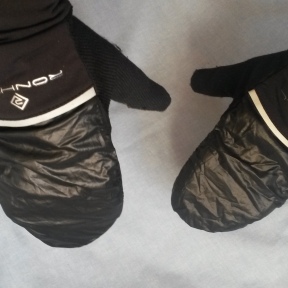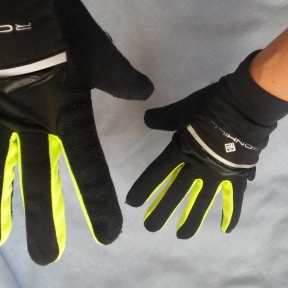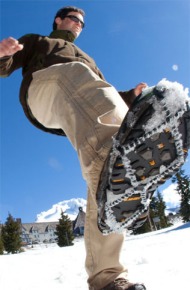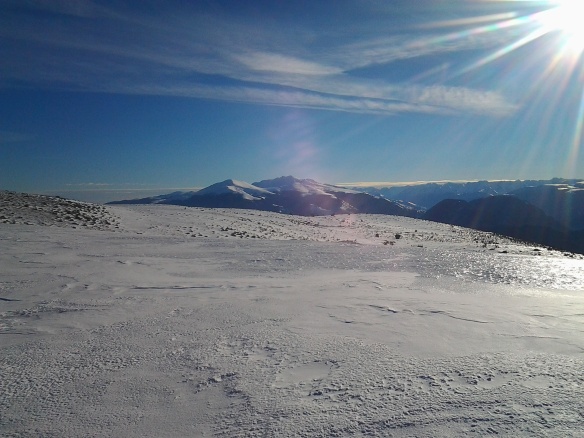Written by Nick Jenkins - http://nearlyshoeless.com
I love winter running, Its the only time of the year that I can actually justify wearing tights in public, in the daytime. Early starts with the head torch, starting off cold under copious layers then warming up and regretting all of those layers. The sound of crunchy snow underfoot, the fleeting glimpse of wildlife in the woods and the lure of snowy peaks… I love it. This article is all about winter running and what you need to do to be able to do it, I’m going to start with the very basics in this post, then part two will be focused on what I think we’re all calling “Alpine running” – crampons and ice axe stuff… But for now we’ll start with the most important bit when running in wintery conditions.
The importance of warmth
It’s a balancing act, putting on the right amount of clothes in relation to the temperature outside – the fundamental requirement is not to freeze your bollocks or tits off. In all seriousness hypothermia is a real thing and could happen if you aren’t suitably attired for the temperature. Personally I can “get away” with shorts in temps as low as 2°C (35.6°F) but as I get older (and perhaps a bit slower) it seems that each year the Lycra is coming out of summer hibernation a bit earlier…
So lets have a look at a what to wear when the temperature creeps towards freezing. The best approach is to combine 3-4 thin layers that you can remove and put back on as necessary. I go for a technical t-shirt under a long sleeve thermal layer, these could be made out of a) Merino wool if you are rich, or b) Polyester if you are not so rich. I go for poly as I found that the merino tops that I can afford often shrink a little in the wash. A quick example of quality is my original long sleeve Helly Hansesn Lifa top which is still going strong after 11 years of use. Bomb proof – and truly deserves the moniker of “Smelly Helly”.
On top of that you may want to add a lightweight fleece top or a sleeveless gillet type of thing.
Finnish off the layering party with either a windproof or waterproof top depending on the weather. More info on “what waterproof in part 2.”
The body will pull heat away from the extremities to protect the core so make sure the hands and feet are toasty warm – I use a combination of proper ski glove mitten type things and normal runners glove – I’ve just purchased a new pair of Ronhill gloves with a tuck-in-able windproof over mitten which are quite frankly really bloody awesome. Here’s a picture


On my feet in winter I always, without any exception wear proper wool hiking socks. This really is my best beginner tip. Wool will stay warm when wet – and you are going to get wet if you run in anything resembling snow. The extra thickness will help with insulation from the ground too. I use socks made by a company called Bridgedale, they are well made and seem to last for ever, one thing you might have to do is remove the insole of your running shoes to accommodate a thicker sock, you can also try sizing up. Two shoes which work well in my arsenal are the Inov 8 roclite 295 and the Saucony Peregrine 4 (I take the insoles out in the Pery’s but not the 295’s). A slightly less minimal shoe is my preference – the increased stack height and added foam will contribute to the insulation from the ground.
Winter isn’t really a time to start barefoot running either, unless you want to be a bit of an attention seeker. You also hear about people who continue with shirtless running in winter… Look, I’ll never call anyone a moron for doing stuff like this, however, if the practices of winter barefooting and non-summer bare chestiness are combined with one of those knowing, smug looks that suggest that the secret of everything has been found… Well… I will most likely refer to a person like that as sactominious twat.
In this case a beard will not be a saving grace.
Back to the advice. On top of your bonce you need a hat, I usually start with a normal beanie, then as I warm up I take that off and pull up the buff (which was around my neck as a scarf) on to my head – clever, I know! On my legs if temps are well below freezing I wear boxer type underpants, long johns and Lycra leggings – I’m a big fan of RonHill Tracksters, they’re not too tight, they have stirrups for keeping them from riding up, they are mega cheap, warm and really these days kinda cool in a retro ironic hipster type way.
The next really important thing to discuss (ladies this one is purely for the chaps) is how to “dress”… Lets face it, it’s difficult not to notice a poorly dressed man, there’s nothing worse than “positioning” yourself to either side when wearing Lycra… The best thing is to go for symmetry and dress down the middle and nothing says “I’m embarrassed about being a man” than wearing shorts over tights. You end up looking like a grownup pretending to be a super hero, its 100% geeky – it just doesn’t look good. I’ve heard it argued that “overshorts” are good if you run in the wind, or if temperatures are really low. This is, quite frankly, a poor argument.
Nothing beats putting on a full windproof over-pant and thus covering the entire leg – if it’s really that cold, then that’s what you need to do. Inov 8 make my favourite, the out of production Mistlite 130 (now updated to the Race Elite 85 windpant) which I’ve used to climb high peaks in raging weather. You can pay a lot more and buy fully waterproof taped over pants… I dare say that they are worth the money but I still have yet to find conditions where my windproof inov-8’s were lacking.
All you need now is a bag to chuck in the discarded layers as you warm up, for long winter runs I need about 10-12 litres of space – I’m currently using the Ultimate Direction PB pack, it is very good.
Before you head out the door take heed of this advice – it’s okay to be wet and warm but not wet and cold, If the weather looks bad then either don’t go for a run, cut it short or wear a proper taped waterproof coat with a hood. As I mentioned earlier, I’ll go a bit more in depth on waterproof shells in part two. We also need to factor in wind chill – running will warm you up and you’ll be fine if you keep running, but if you need to stop for any reason you’ll get cold quickly. On big outings I always bring an extra windproof layer that I can bundle over or under my waterproof, takes hardly any space and can really make a difference. In recent years we’ve seen the proliferation of micro down jackets, which I have yet to try but look like a nice lightweight alternative to a fleece used as a midlayer, the only down side (err…sorry) is that once wet, duck down will be really cold. A waterproof outer layer is a must and even then in really bad weather its hard to avoid a soaking. So, remembering that wet and warm is best, we’re probably better off using a fleece as a mid layer.
Traction.
Before I wrap up part one I will touch on traction and grip. Snow is a bit slippery at the best of times, but honestly if there is a lot of it and its soft then a fall isn’t the end of the world – try out slushy snow or powder without any extra traction devices, I think shoe skiing should be recognised as a sport on its own… You need more grip when you encounter ice – after a cycle of freeze/thaw the snow will get more and more consolidated and turn in to a sheet of neve or snow ice.
On a woodland trail a slip can be dangerous, on a mountain side a slip can be life threatening. More about the high mountain stuff in the next article, but for now we’ll touch on traction options for general trail running outings.
Your traction options..
You can screw permanent spikes in to your shoes, there are official products available or you can use Tek screws
If that doesn’t float your boat, perhaps you want something less permanent – you could purchase a product like Yaktrax which slip over the shoe. They have a number of different models to choose from – some use a metal ringed cord system similar in idea to snow chains for your car tires. They also offer a product that has tiny spikes or dobs under the forefoot area. Great for low level stuff and potentially the more comfy option for all day use.


Further up the hill I’d encourage the use of micro crampons such as Kahtoola Microspikes or Hill Sound Trail Crampon. Depending on your experience these could quite happily see you through sections of relatively technical stuff such as wide slopes of neve snow, iced up ridge running or single track and even short sections of more technical mountain – there certainly is a bit of a debate about when a trail runner should put away the micro crampons in favour of real crampons with front points, micro’s are without a doubt the easier option to “run” in however, you wouldn’t want to climb a frozen waterfall…But that’s not what we’re really contemplating is it? We’re runners and we need to draw a distinction between true alpinism and “alpine running” which I will ponder over more in part two…
…Until then…Happy Winter Trails.
Hey – if you’ve like this article, why not hit the share button on your favourite social media outlet or give me a little like button love. All the links above are non-affiliated you won’t be helping me at all if you buy anything as a result of reading this, but a share, well a share is worth so much more than money…
A little disclaimer…Trail running is dangerous and mixing it with winter is surely a recipe for disaster. I take no responsibility if you hurt yourself after reading my blog. None at all. The information provided is my personal opinion only – you follow it at your own risk. Really, I think it’s best that you just stay indoors with a nice hot cup of tea until the spring time.






